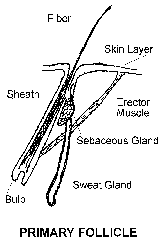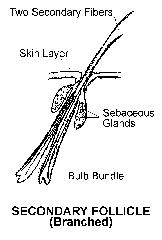





| Home | The Start | The Sheep | The Articles | The Rugs | The Book | Our Blog | Contact Us |
| Originally published in the March 2000 issue of Marker, quarterly magazine of the National Colored Wool Growers Association. Reproduced here with permission. See also Part 2, Genetics and Nutrition and Part 3,
Harvesting and Handling. The History |
| Ancestors of modern sheep had a double coat consisting of long hairy fibers, which served to protect from the weather and insulate from the elements, and a soft downy undercoat, which gave additional insulation and was shed annually. The primary follicles of these primitive sheep produced the outer coat of hair. The secondary follicles produced the seasonal soft fine undercoat. The undercoat grew during the warm months, was idle during the winter months, and was shed in the spring. Wool, as we know it, developed from this undercoat, and sheep of today have a variety of fiber diameters from superfine to coarse. While remnants of these ancient breeds still exist, sheep have evolved into four distinct breed types: the fine wool type of African and Spanish origin; the medium wool type and the long wool type, both of European and English origin; and the carpet wool type, mostly of Asiatic origin. In modern sheep the primary fibers have been reduced in size and numbers, the density of secondary fibers have increased, and the seasonal effects of growth reduced, eliminating shedding. The result is a relatively uniform coat of wool fibers. |
| The Follicles Wool fibers are outgrowths of the skin; the follicle is an indentation of the skin's outer layer. Basically, the follicle consists of a bulb down deep and a shaft leading from the bulb up to the skin surface. The fiber originates in the bulb and is pushed up the shaft, where it undergoes elongation and hardening or keratinization. From two types of follicles, the primary and secondary, three types of fibers are produced: true wool, heterotype/medullated, and kemp. |
| The larger primary follicles produce wool fibers, as well as being the normal source of heterotype, often medullated, fibers and kemp. The primary follicle is unique as it has a sweat gland, a sebaceous or grease gland, and an erector muscle. The sebaceous gland coats each fiber with a greasy secretion before it reaches the skin surface. This greasy secretion also keeps the skin soft and protects both the skin and the fiber from drying out. The sweat gland secretes a soapy perspiration called suint, which combines with the grease to produce the yellow colored yolk. When the erector muscle contracts, the outer coat hairs stand up to trap the air and cause pressure on the sebaceous gland releasing the suint. One primary follicle is capable of producing only one fiber. |  |
 |
In contrast, the smaller but more numerous secondary follicles grow only wool fibers and lack the sweat gland and erector muscle. One secondary follicle can produce up to eight wool fibers. The secondary-primary ratio is the number of secondary follicles for each primary follicle, and varies by breed, i.e. 20:1 in a merino to a 6:1 ratio in a Lincoln. This ratio can be a useful indicator of the quality, density and fineness of wool production in sheep. |
The Fibers
|
| The Development The central primary follicles develop in the fetus about 60 days into gestation. At between 70 to 90 days the two lateral primaries complete the trio group. After 95 days the secondary follicles begin to develop, the first ones are more apt to be branched and can produce up to eight wool fibers from one follicle. After about 120 days the secondaries are more apt to be an unbranched-type, thus producing only one fiber. All of the primary follicles are formed and growing fibers by the time the lamb is born. While most of the secondaries are developed before birth, they may not mature or produce fiber until after birth. Normally all follicles are producing fibers by a month after birth. The Benefits By increasing or assuring adequate energy or protein levels in the ewe at 95 days into gestation, the branching secondaries can be encouraged, resulting in finer, denser fleeces. By increasing the secondary/primary ratio, we can possibly effect the quality, fineness and density of the wool production in our sheep. The amount of wool produced by a sheep depends on the numbers of follicles actually growing a fiber and how fast that fiber grows; which in turn is related to nutrition, health, genetics, and other factors...but that�s next time. |
| Home | The Start | The Sheep | The Articles | The Rugs | The Book | Our Blog | Contact Us |


